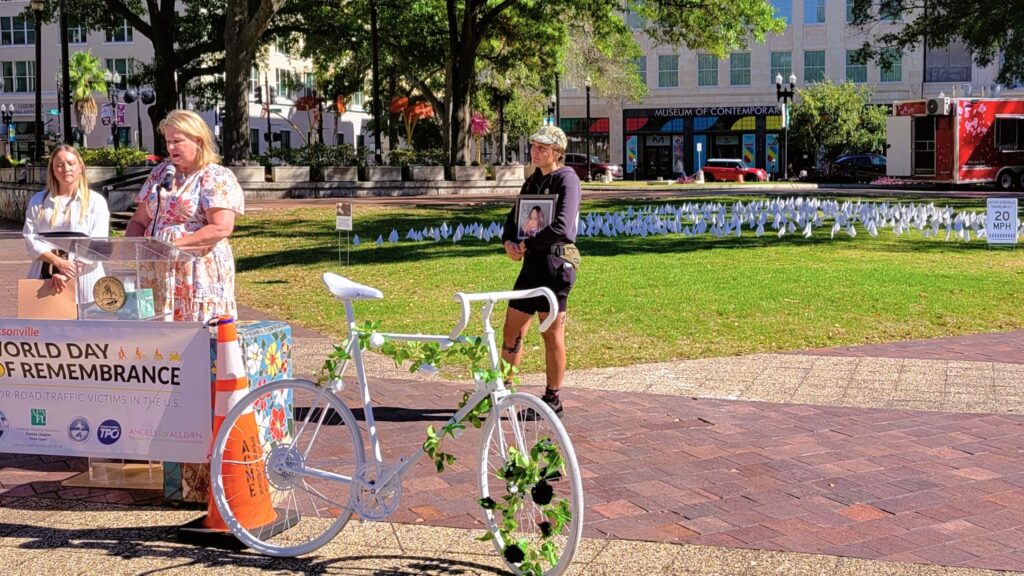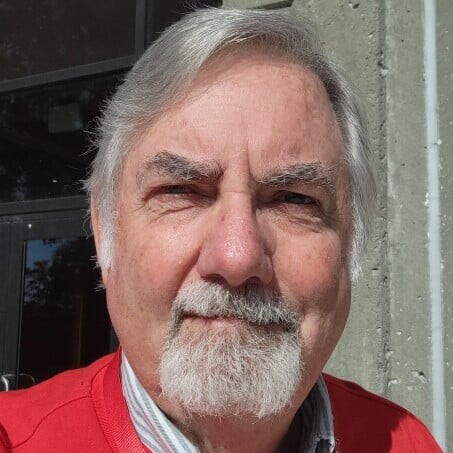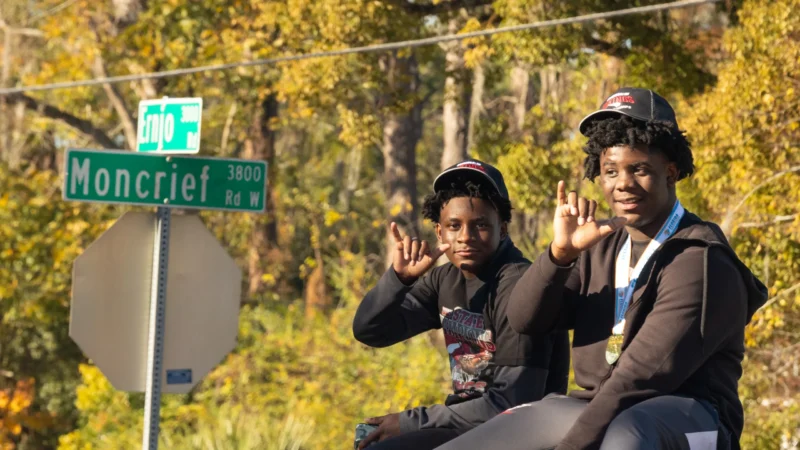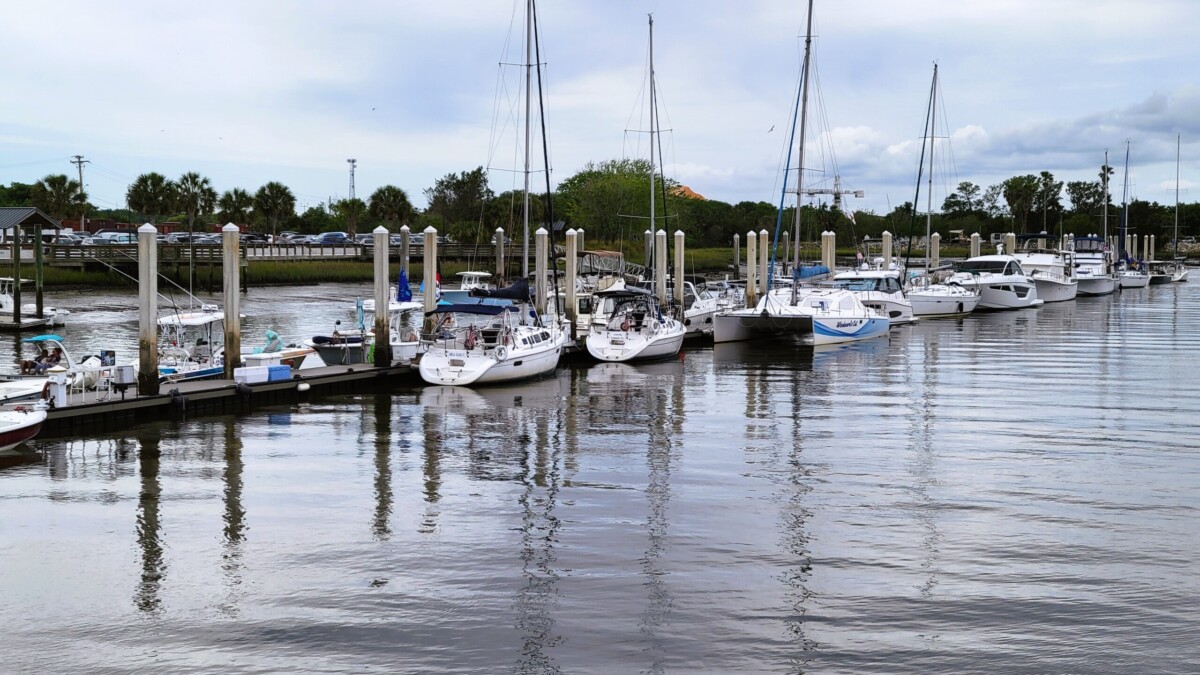Allison Haramis was 15 when she died in a car crash in 2009. She was riding home from school with friends on the Buckman Bridge.
The high school student was one of 122 people who died on Duval County roads that year.
This year, 133 people have died in traffic crashes and bicycle and pedestrian accidents in 11-plus months. That compares with 163 for all of last year.
Officials held a World Day of Remembrance Friday at James Weldon Johnson Park to honor those who have died in crashes this year and previous years. The city event, co-hosted by Jacksonville’s Bicycle and Pedestrian Advisory Committee, also honored and supported those whose family members were victims.
After her daughter’s death in 2009, Drew Haramis established Angels for Allison, a nonprofit that has helped 1,200 families across Northeast Florida with over $1 million in financial assistance associated with funeral costs.
Speaking at Friday’s remembrance, Haramis said something must be done about the “unnecessary deaths on our roadways.” She urged officials to do more to prevent fatal crashes.
“These are preventable — preventable tragedies,” Drew Haramis said. “Each number represents someone’s child, someone’s beloved person in their family, honestly someone’s whole world. … May we find strength in community, comfort in faith, and the courage to make our roads safer so that no other parent has to face the journey we walked. Let us live each day fully, just as Allison did.”

City officials have embarked on a new program called the Vision Zero Action Plan. Supporters say it will do what Haramis and others want: ensure that no one else dies in a car crash or hit while walking or bicycling.
“Sidewalks and lighting is a big deal if you are walking to school one morning and it is dark. These are the types of improvements we are talking about here,” said Fred Jones, a planning design director at Haskell working with the Vision Zero task force and JTA and other agencies. “Through these plans we will be working to identify the list of improvements that we can collectively target. We have got the money to do it. We just need to do it.”
Deaths in local traffic
Jacksonville is the 15th most-dangerous metropolitan area for pedestrians nationwide, based on reported traffic crash fatalities, as reported in Smart Growth America’s annual Dangerous by Design Report. State Department of Health statistics on crash-related fatalities in Florida show that Duval County recorded a high of 203 deaths in 2020, followed by 194 deaths in 2021.
Between 2021 and 2023, 508 people lost their lives in traffic crashes in Jacksonville. Some 147 of them were bicyclists or pedestrians.
The deaths were represented Friday with 508 white flags planted in the entrance of James Weldon Johnson Park outside City Hall. Each flag represented a person who had lost their life on Jacksonville's roads in the last three years. Nearby were a white "ghost bike," plus flowers and photographs of loved ones.
The number of deaths is unacceptable, said City Councilman Jimmy Peluso, whose district includes Downtown and Riverside. One priority he said he has pursued is having better bicycle and pedestrian infrastructure so residents can "get from home or work in a reasonable time and not be afraid to be hit by a car."
"I made sure that we looked at our Downtown area in particular to make sure we are creating dedicated, protected bike lanes that connect us not only to our places of business, but to the Emerald Trail and the Riverwalk," he said Friday. "These are basic things that we should have been doing 20, 30, 40 years ago. But instead, it was 'Let's build another road.'"
So far, Jacksonville has shown a downward trend in bicyclist deaths per 100,000 residents in recent years. The National Highway Safety Administration once ranked the city as the third most-dangerous metropolitan area for bicyclists.
Vision Zero's goals
The high number of traffic deaths became the impetus for the city's Vision Zero plan. The city plans community education as well as road design changes to achieve the goal of reducing traffic deaths to zero and reducing serious injuries in half by 2035, said city bicycle and pedestrian coordinator Matt Fall, who is working on Vision Zero.
Friday's memorial can help educate people to the severity of the issue, he said.
“An event like Friday really shows you, hey, these were individuals; these are actual human beings that had a network of friends and family that they are not going home to," Fall said. "And these people are affected, and there are repercussions that go throughout the entire community that you need to shine a light on and say, hey, these are people and we need to take this very seriously.”
Vision Zero includes in-depth studies to understand the causes of accidents, what is termed high-injury networks -- stretches of roads where the highest concentrations of collisions result in fatal or serious injuries, Fall said.
That would help pinpoint specific roads and intersections that have the highest rates of accidents, then find ways to stop them. Other solutions include designing and building improved crosswalks, creating bicycle lanes with wider separation from traffic lanes and establishing new speed limits to improve safety.
"We can begin to look at the high-injury network and say, what can we fix as the city?" Fall said. "What are the intersections where we can start to look at protected intersections designs and hardening the median, channeling turning movements and slowing cars down. These are all of the things we can do, we can start to do on our high-injury network."
The same can be done on the city's state roads, he said. And the project will raise public awareness and get community involvement, as well as implement safety measures in select areas to showcase their effectiveness and encourage wider adoption.
Project planners will work closely with the Florida Department of Transportation, Jacksonville Transportation Authority and local law enforcement to coordinate efforts.
For skeptics who say that there is no way to reduce traffic deaths to zero, Fall points to the successes of a similar program in Hoboken, New Jersey. That effort resulted in no traffic fatalities in the three years after it was instituted in 2018.
Hoboken instituted bicycle lane changes and improvements at pedestrian crossings. The number of vehicle collisions dropped by 27%; the number of pedestrians hit by vehicles fell 35%; and the number of bicyclists hit declined by 11%, according to Hoboken's Vision Zero website.
The good news is that Jacksonville is one of two cities that have improved in the Dangerous by Design Report. But, "there's still a lot of work to do," Fall said.
"We don't want to start patting ourselves on the back just because we are now at No. 15," he said. "We are looking to bring all traffic fatalities and serious injuries to zero, and that is why the city embarked upon this effort."







